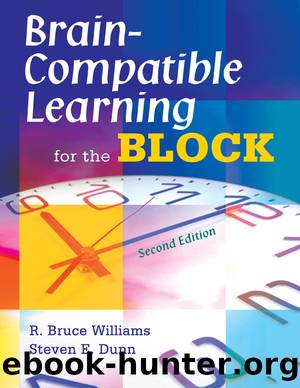Brain-Compatible Learning for the Block by Williams R. Bruce;Dunn Steven E.;

Author:Williams, R. Bruce;Dunn, Steven E.; [Williams, R. Bruce]
Language: eng
Format: epub
ISBN: 1650894
Publisher: Corwin Press
Published: 2007-12-14T00:00:00+00:00
Inquire Activity Option A
Objective: Students define terms related to prejudice, justice, and bias.
ATTEND
Students write their responses to the following reflective questions regarding bias, prejudice, and justice in their personal journals.
⢠What does the word bias mean to you?
⢠What are some of your biases?
⢠What does the word prejudice mean to you?
⢠When have you acted prejudiced? Why?
⢠When did someone act prejudiced against you? What happened?
⢠Is âjustice for allâ a myth? Is it possible to attain? Under what conditions/circumstances is it possible?
⢠How is the quality of justice related to bias and prejudice?
⢠On a scale from one to ten (one being completely unjust and ten being absolutely fair and equitable), how would you rate yourself? What circumstances can or have had an impact on how fair you are?
EXPERIENCE: âMIX AND MATCHâ
Early in the unit, students were instructed to create an index card for each character they encountered and every incident they felt was significant in To Kill a Mockingbird. (The cards could have also been used to study the plot of the novel in a previous lesson.)
Students
⢠form groups of four and select a âsecretary";
⢠as a class and guided by the teacher, create definitions for the following words: bias, bigotry, ethics, injustice, intolerance, justice, morality, prejudice, racism, stereotype, and tolerance.
Each secretary
⢠records the collective definitions on index cards for his or her group.
Students
⢠working in their small groups, recall or cite a specific incident from the book that represents or depicts each of the eleven vocabulary words (there may be more than one character or incident per word).
The teacher
⢠debriefs each group by leading a brief discussion of the examples students identified.
Inquire Activity Option B
Objective: Students create a graphic organizer analogy chart.
ATTEND
The teacher directs student attention to a quote by Victor Hugo by asking the students to
⢠look for the images Victor Hugo uses to express universal problems of prejudice;
⢠think about how Hugo might define prejudice;
⢠imagine a simile that illustrates your definition of bias.
EXPERIENCE: âHAUNTED BY PREJUDICEâ
Superstition, bigotry and prejudice, ghosts though they are, cling tenaciously to life; they are shades armed with tooth and claw. They must be grappled with unceasingly, for it is a fateful part of human destiny that it is condemned to wage perpetual war against ghosts.
âVictor Hugo from Les Miserable, 1862
The teacher
⢠models how to create the analogy chart using the Hugo quote; and
⢠asks students to identify three supporting reasons for Hugoâs analogy (Figure 3.6 provides an example).
Download
This site does not store any files on its server. We only index and link to content provided by other sites. Please contact the content providers to delete copyright contents if any and email us, we'll remove relevant links or contents immediately.
Macmillan Primary Grammar 2 Pupil's Book by Unknown(370)
Figuring Out Fluency in Mathematics Teaching and Learning, Grades K-8 by Jennifer M. Bay-Williams & John J. SanGiovanni(332)
The Principal's Guide to Curriculum Leadership by Sorenson Richard D.;Goldsmith Lloyd M.;Mendez Zulma Y.;Maxwell Karen T.;(255)
English Grammar Practice--The Noun by Roxana Nastase(221)
Learning from Accidents 3rd ed by Trevor Kletz (2001)(216)
Harnessing Technology for Deeper Learning by Scott McLeod(202)
Text-Dependent Questions, Grades K-5 by Douglas Fisher & Nancy Frey & Heather Anderson & Marisol Thayre(200)
English Language Program Administration by Unknown(191)
A Guide to Curriculum Mapping by Hale Janet A.;(190)
Deep Change Leadership by Reeves Douglas;(185)
How to Do Everything with Google Tools by Unknown(178)
The Grammar Teacher's Activity-a-Day by Jack Umstatter(174)
The Power of SMART Goals by Conzemius Anne;O'Neill Jan; & Anne Conzemius(171)
Beyond the RTI Pyramid by Bender William N.;(155)
Using Data to Close the Achievement Gap by Johnson Ruth S.;(151)
Using Equity Audits to Create Equitable and Excellent Schools by Skrla Linda E.;McKenzie Kathryn B.;Scheurich James Joseph;(146)
Aligning and Balancing the Standards-Based Curriculum by Squires David A.;(141)
Differentiated Instructional Strategies for the Block Schedule by Gregory Gayle H.;Herndon Lynne E.; & Lynne E. Herndon(132)
You've Got to Reach Them to Teach Them by Schreck Mary Kim; & Schreck(131)
